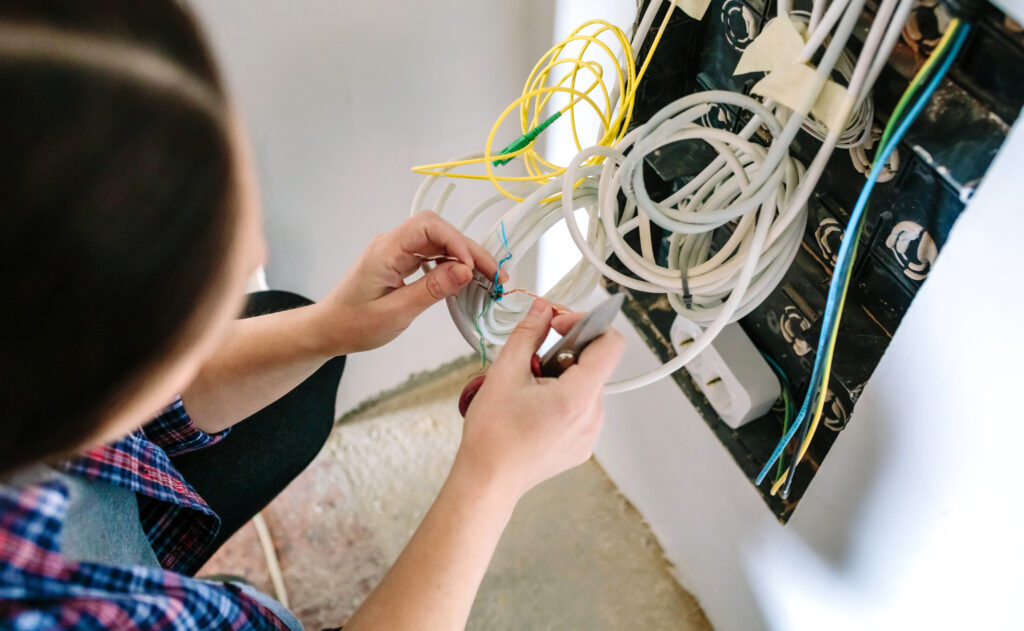Wiring installation is a fundamental aspect of creating a safe and functional electrical system in your home. Whether you’re embarking on a DIY project or considering a professional upgrade, understanding the basics of wiring can make all the difference. This guide provides a comprehensive overview of what you need to know before you start, including essential tips, common mistakes to avoid, and when to call in a professional.
Understanding the Basics of Wiring Installation
Before diving into a wiring installation project, it’s crucial to grasp the fundamental concepts. Here’s what you need to know:
1. Types of Wiring
Different types of wiring are used for various applications:
- Romex Wire: A type of non-metallic sheathed cable, Romex is commonly used in residential wiring. It contains insulated wires within a plastic sheath and is ideal for general-purpose wiring.
- Copper Wire: Known for its excellent conductivity, copper wire is used in most residential and commercial wiring applications. It is flexible, reliable, and capable of carrying electrical currents efficiently.
- Fiber Optic Cable: Although not used for standard home wiring, fiber optic cables are essential for high-speed data transmission and communication systems.
Keywords: home wiring, electric wire, Romex wire, copper wire, fiber optic cable
2. Essential Wiring Components
To perform a successful wiring installation, familiarize yourself with key components:
- Electrical Outlet Wiring: This involves connecting wires to the terminals on an outlet to ensure proper function and safety.
- Wire Connectors: Used to join wires together, wire connectors come in various types, including twist-on and push-in connectors.
- Electrical Wire Connectors: These are crucial for making safe and reliable connections in your electrical system.
Keywords: electrical outlet wiring, wire connectors, electrical wire connectors
Essential Tips for Wiring Installation
Proper planning and execution are critical for a successful wiring project. Follow these tips to ensure your installation goes smoothly:
1. Plan Your Wiring Layout
Planning is essential for a successful wiring installation:
- Assess Your Needs: Determine what wiring upgrades or installations are needed, such as adding new outlets, installing ceiling fans, or upgrading your electric panel.
- Create a Wiring Diagram: Sketch out your wiring layout to visualize the installation process and avoid overlooking any details.
Keywords: wiring, wiring installation, attic fan installation, ceiling fan installation, electric panel upgrade
2. Follow Safety Protocols
Safety is a top priority in any wiring installation:
- Turn Off Power: Always turn off the power at the circuit breaker before starting any wiring work to avoid electrical shocks.
- Inspect Wiring Regularly: Regular inspections and maintenance help identify potential issues before they become significant problems.
- Hire a Professional: For complex installations or when in doubt, consult a licensed and insured electrician to ensure the work meets safety standards and code requirements.
Keywords: electrical outlet installation & repair, inspections & wiring, best local electrician
3. Use Quality Materials and Tools
Using high-quality materials and tools contributes to a successful wiring installation:
- Select the Right Wire: Choose the appropriate type of wire for each application. For example, Romex wire is commonly used for general wiring, while fiber optic cables are used for high-speed data transmission.
- Invest in Quality Tools: Proper tools, such as wire strippers and voltage testers, make the installation process smoother and safer.
Keywords: wire connectors, electrical wire connectors, copper wire
4. Address Common Wiring Challenges
Be prepared for common wiring challenges:
- Overloaded Circuits: Avoid overloading circuits by distributing the electrical load evenly and upgrading your electric panel if necessary.
- Dimming Lights: If you notice dimming lights, it may indicate a problem with wiring connections or circuit capacity.
- Faulty Outlets: Ensure that outlets are properly wired and grounded to prevent issues such as sparks or frequent tripping.
Keywords: circuit breaker replacement, electric panel upgrade, electrical outlet installation & repair san ramon
When to Call a Professional
While DIY wiring can be rewarding, some situations require the expertise of a professional:
- Complex Installations: Tasks such as upgrading an electric panel, installing a home solar system, or integrating an electrical vehicle charging station are best handled by a professional.
- Safety Concerns: If you’re unsure about any aspect of wiring installation or encounter issues such as frequent breaker trips or flickering lights, consult a licensed electrician to ensure safety and compliance.
Keywords: electrical vehicle charging station, home solar system, subpanel installation
Frequently Asked Questions (FAQ)
Q: What types of wire are used in home wiring?
A: Common types of wire include Romex wire for general purposes, copper wire for most applications, and fiber optic cables for data transmission.
Q: How do I know if my wiring is up to code?
A: Wiring should meet local electrical codes and standards. For verification, consult a licensed electrician or have your wiring inspected.
Q: Can I install wiring myself?
A: While DIY wiring is possible for those with experience, complex installations and safety-critical tasks should be handled by a professional.
Q: What are the benefits of upgrading my electric panel?
A: Upgrading your electric panel can handle increased power demands, improve safety, and prevent frequent breaker trips.
Q: How often should I have my wiring inspected?
A: It is recommended to have your wiring inspected every 3-5 years, or more frequently if you experience issues such as flickering lights or frequent breaker trips.


